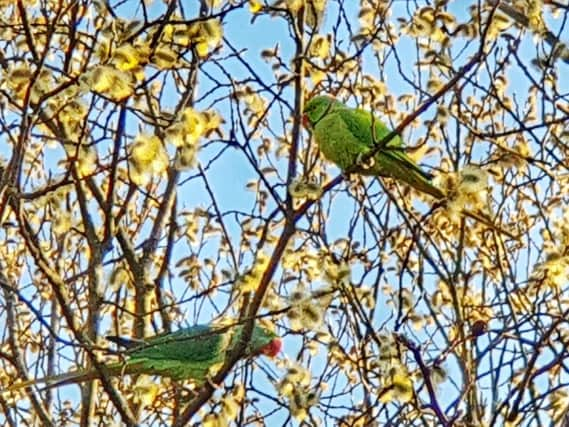Burnley's 'exotic' visitors are certainly ruffling a few feathers


Two exotic parakeets were caught on camera by Burnley resident Helen Robinson who said when she first saw them she thought she was 'hallucinating.'
Helen spotted the birds in a tree in Widow Hall Road while she was sat in her car waiting to collect her husband Graham from his workplace.
Advertisement
Hide AdAdvertisement
Hide AdShe said: "I thought I was hallucinating under pressure that Covid 19 is having on my mental health.
"I saw a magpie and was looking out for the other one when the parrots flew by and landed in the tree.
"I thought they looked odd for magpies so I watched for a bit and then got out of the car to cross the road and take photos."
"Two people walked past who tnought I was nuts but thankfully they saw them too and the pictures prove they were there. There were three but one of them was camera shy."
Advertisement
Hide AdAdvertisement
Hide AdThe parakeets are believed to have been in the area for a while and make quite a racket.
After doing some of her own research Helen believes the birds may be migrating north from other colonies around the world.
Research has shown that Britain has a booming parakeet population which has grown from numerous accidental and intentional pet releases.
To solve the mystery, scientists used geographic profiling used to track down criminals - and analysed patterns of parakeet sightings over the past 50 years.
Advertisement
Hide AdAdvertisement
Hide AdScientists have recently debunked several myths to explain the existence of parakeets in the UK including one that the legendary guitarist Jimi Hendrix released a pair on Carnaby Street in London, in the 1960s.
One popular theory is they were refugees from the film set of The African Queen, starring Humphrey Bogart and Katharine Hepburn and shot in Ealing in 1951 and another idea suggests the birds kept at Syon Park escaped in the 1970s when a plane crashed through the aviary roof, while a fourth theory blamed the damage to aviaries after the Great Storm of 1987.
However, no evidence to support any of the myths surrounding the bright green birds' origins in the UK was found, according to a study published in the Journal of Zoology.
According to the Royal Society for the Protection of Birds, the ring-necked or rose-ringer parakeet is perhaps our most abundant naturalised parrot, which became established in the wild after captive specimens escaped in the 1970s.
Advertisement
Hide AdAdvertisement
Hide AdBut it is more common to see the distinctive green birds in the south-west, instead of the chilly north.
An RSPB spokesman added: "The ring-necked parakeet's native range is a broad belt of arid tropical countryside stretching from west Africa across lowland India south of the Himalayas, where it is a common bird.
"Despite their tropical origin, parakeets are able to cope with the cold British winters, especially in suburban parks, large gardens, and orchards, where food supply is more reliable."